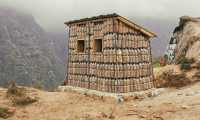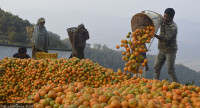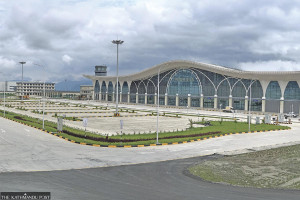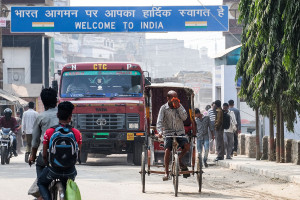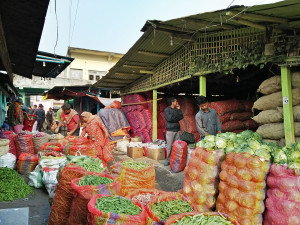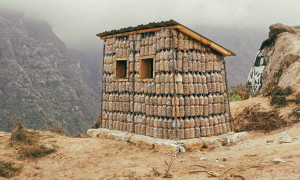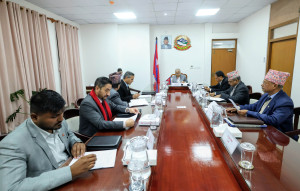Money
Frequent disruptions on highway drive up trade costs, exporters say
Floods, landslides, and poor logistical infrastructure have raised freight charges and insurance premiums, eroding Nepal’s export competitiveness.
Post Report
Frequent floods and landslides along the Tribhuvan Highway—a key trade route linking Kathmandu with domestic and international markets—have not only pushed up transportation costs but also raised insurance premiums for freight, exporters say.
“The disturbances on the highway during both rainy and winter seasons have increased freight costs, and as a result, insurance premiums are also rising, adding to overall trade expenses,” said Rajendra Sangraula, president of the Nepal Freight Forwarders Association, at a workshop on Developing Competitiveness and Promoting Apparel Export jointly organised by the South Asia Watch on Trade, Economics and Environment (SAWTEE) and the Garment Association Nepal (GAN) in Kathmandu on Thursday.
Sangraula said the introduction of the Tax Deducted at Source (TDS) provision in the fiscal year 2019–20 has further hiked freight costs by around 2.5 percent.
“We recently received a circular stating that countries having a Double Taxation Agreement (DTA)—an agreement to prevent the same income from being taxed twice—are exempt from TDS. However, shipping companies are not registered in Nepal, so we haven’t been able to benefit from that provision,” he said.
He added that the absence of a multimodal transport document has made shipping companies more arbitrary and reluctant to register in Nepal. TDS and DTA are not applied in the same jurisdiction but rather function in coordination between countries that have signed tax treaties. While TDS is a domestic mechanism, DTA provides relief to taxpayers involved in cross-border transactions between two signatory states.
Experts also pointed out that poor airport infrastructure and rising warehouse costs have worsened Nepal’s trade competitiveness. Warehouse expenses increase by about 10 percent every two years, further inflating overall trade costs.
The Freight Forwarders Association urged the government to start assessing alternative seaports such as Mundra Port and Jawaharlal Nehru Port in Mumbai, which serve as gateways for trade with Western countries. “A dry port is under construction at Dodhara Chandani, and if we fail to start using western ports for our exports, we will be forced to continue trading through Kolkata, which is not cost-effective,” Sangraula said.
Trade and logistics expert Rajan Sharma said Nepal’s export competitiveness is being eroded by high logistical costs and long transit times. “Transhipment and waiting times alone raise export costs by between $300 and $600 per consignment,” he said.
He noted that transit and dwell times across all modes of transport are excessive—it takes two days for goods to reach Birgunj from Kathmandu, 25 days from Birgunj to Visakhapatnam, and 18 days from Birgunj to Kolkata. These delays not only increase costs but also disrupt the timely delivery of goods.
Sharma added that Nepal lacks large-scale warehouses, even within the private sector, which prevents small and medium enterprises from efficiently storing, consolidating, and forwarding goods. The absence of third-party logistics services further compounds the problem.
Experts suggested that the government should provide incentives to reduce logistics costs—such as lowering terminal handling and warehousing charges—to encourage exports.
Garment producers said global apparel consumption is on the rise, and Nepal should seize this opportunity. The country already exports nearly 30 percent of its textile-related products, including thread, yarn, and fabrics.
Suyash Khanal, CEO of the Garment Association Nepal, said the global apparel market is expected to reach $1.79 trillion by 2024, with the US alone accounting for$365 billion. “This shows the huge potential market for a country like Nepal,” he said, noting that the average American household spends around $162 per month on clothing.
Another expert projected that global apparel consumption will increase by 63 percent by 2030—from 70 million tonnes now to 100 million tonnes.
Nepal’s Trade Integration Strategy 2023 aims to increase the ratio of goods and services exports to GDP from 6.3 percent in the base fiscal year 2021–22 to 20 percent by 2027-28. Insiders say expanding exports of products like carpets and apparel is key to achieving this target.
However, Khanal pointed out that exporters currently face a steep tax burden when promoting their products abroad. “To participate in trade fairs, exporters must pay 28 percent in taxes—15 percent TDS and 13 percent VAT—which discourages potential exports from entering international markets,” he said.
He warned that once Nepal graduates from Least Developed Country (LDC) status, the rules of origin will change drastically. “If we don’t start promoting exports now, there will be a massive decline in exports after graduation,” Khanal said.
Although the NTIS includes several measures to promote exports, the lack of adequate budget allocation has hindered implementation and produced little tangible progress. The government has allocated only Rs30.50 million to implement the NTIS in the current fiscal year.
Participants at the workshop also noted that Nepal’s export destinations remain heavily concentrated in a few countries. They urged the government to diversify markets so that changes in tariff regimes—such as those of the US—do not disrupt export performance.




 18.12°C Kathmandu
18.12°C Kathmandu
